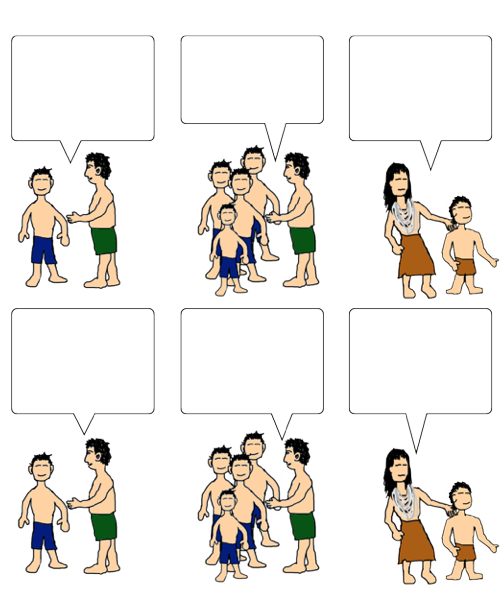Commands- telling people what to do – are very useful things for language learners – both because in most languages they are often simple and short and therefore relatively easy to learn, and also because using a command can get things done!
Commands – telling people what to do – are very useful things for language learners – both because in most languages they are often simple and short and therefore relatively easy to learn, and also because using a command can get things done!
To give a command to an individual person, put -p at the end of
the verb, if it is preceded by a vowel.
But if there is a consonant before it, the -p disappears.
After a vowel:
After a consonant there is no -p
When using the -p command, if the root is two syllables, the primary stress often shifts to the second syllable and the first syllable stress becomes less strong.
There is no stress change for a verb that ends in a consonant (and therefore does not have a -p in the command form).
Making verbs into commands
Make the following verb roots into commands. (Some won’t change at all except for your tone of voice.) Speaking of tone of voice, we recommend that you read the Konkow words and sentences you see out loud, to practice your pronunciation and start getting those words into your memory.
To give a command to two or more people, use -wa after a vowel, but after a consonant (w) disappepars.
Practice changing Konkow verbs into commands.
(w) doubles that consonant
after vowel
after vowel
(w) doubles that consonant
(w) doubles that consonant
The suffixes you just learned, -p and -wa/-a, are used if you are telling someone to do something right now. But if you are telling someone to do something at some later time, there are different endings that you put in before -p or -wa/-a.
Examples with –sy/su and -p
Examples with -k’uton. (The -p will never show up because -kuton ends in a consonant.)
Examples for plural future commands (unlike the singular, you can see the plural form with -k’uton):
Change these “now” commands to future commands, using -sy.
Now change the same commands to future commands using -k’uton.
-be 'permissive' Dr Ultan translates as 'you may do it' or 'you’d better do it' or 'be sure to do it'
Take any 5 commands from the above exercises and turn them into more polite commands by adding -be in front of the command ending.
Notice that a couple of them already have -be.
The various verb and noun endings (suffixes) have a specific order they should occur on after the root of the word. The command forms are the last to occur in a word -- other suffixes, such as -be, come before the command.
-be is in class 13 (meaning there are 12 other categories of endings that would be placed before it!)
-sy/su is in class 16.
-k’uton is in class 17. Even though Ultan writes that you can either use -sy/su or -k’uton, he also writes that he has sometimes seen both together, with -sy first, so that is why he showed them as being in different classes. In fact, here is an example where three of the suffixes we are talking about occur together.
-p and -wa are in class 18. Thus the order for the endings we have talked about in this lesson will always be:
Do a short exercise in “parsing.” As you have seen, we put a dash before suffixes when we are showing them by themselves, to show that they are not the root of the word, but are components that come after the root. We can also use a dash to separate the suffixes from each other when we want to show the components of a word.
Below are 4 sentences that are commands. Read them out loud. Then rewrite the underlined verb that has the command endings on it by putting a dash before each of the command components we have been talking about, and write down each component’s translation in English. The first one is done for you as an example.
Add imperatives to the thought bubbles using the new vocabulary from this lesson and words from the other lessons. Put an appropriate imperative in the talk bubbles for something the speaker wants to be done right now in the first row. Put an appropriate imperative in the talk bubbles for something the speaker wants to be done at a later time in the second row.

Now go use these commands with real people, or your pets, or your plants, or the sky!
singular -p -p after a vowel mop!
Drink! (singular, now)
Come eat! (singular, now)
plural -wa -wa after a vowel ʔỳjé:wa!
Come here! (plural, later)
(w) doubles that consonant ʔỳsíppa!
Get out! (plural, later)
future -sy
w/ singular -p -sy-p after a vowel or consonant pébesỳp!
Eat! (e.g. when you get there)
pinsyp!
Listen! (e.g. when you go to class)
future -sy
w/ plural -wa -sy-wa after vowel or consonant nìk bòlopajbésywa!
Help me! (e.g. when I do it)
future -k'uton
w/ singular -p -k’uton
-p is ∅ after a consonant
RULE 1 màhwó:k’úton!
Clap your hands! (e.g. after he sings)
future -k'uton
w/ plural -wa -(w)a after a consonant
(w) doubles that consonant
RULE 2 ʔỳhjo’e:k’utonnà!
Be careful! (plural, when you get there)
Other points in this chapter:
- -be makes a command more polite.
- All verb endings go in a certain order. The order is shown by the listing of position classes in the verb chart.
- -p and -wa are in class 18. Thus the order for the endings we have talked about in this lesson will always be:
Want to learn more? All the Mary Jones videos lessons are available HERE
